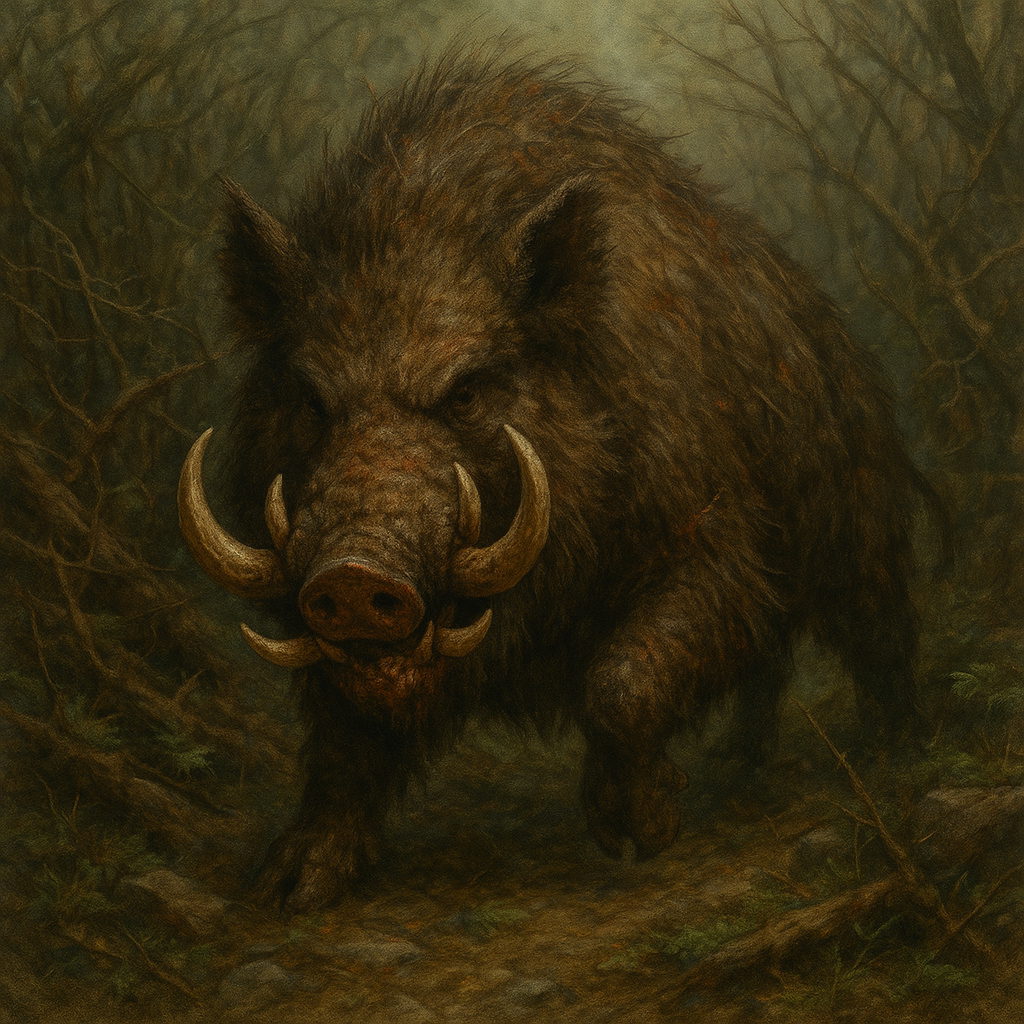Brambleboars
"Kill it clean or don’t bother at all. An angry one’ll tear through your whole party, you understand?."
There are beasts in Everwealth you can run from. The Brambleboar isn’t one of them. A walking juggernaut of tusk, rage, and hide thick enough to laugh at small blades, this four fork-tusked terror doesn’t warn, it charges. Found wherever the brush grows thick and old blood stains the roots, Brambleboars are less animal, more avalanche. Their territory becomes a maze of gored trees, shredded undergrowth, and hoof-churned soil; their scent, a pungent mix of rot and churned root, lingers long after they’ve gone. But make no mistake, they rarely go. They own their thickets, patrolling the same trails for years with the stubbornness of a mountain and the temperament of a storm. Most that cross paths with a Brambleboar don’t walk away. Yet still, the desperate and the hungry hunt them, for their meat is a feast, their tusks fetch a fortune, and their hides turn aside swords. Just pray your kill is clean. Anything less, and you’ll find out firsthand what happens when the woods fight back.
Basic Information
Anatomy
Brambleboars are low-slung, barrel-chested creatures with thick, wiry hair matted in mud, blood, and brambles from making the plants their dens; Their fur exceptionally thick, Brambleboars have been seen gleefully rolling in thick briar bushes to scratch themselves, the standing theory such fauna is among the few things in their natural habitats that can. Their most distinct features are their four tusks: two lower and two upper, each curving outward with an additional hooked scythe protruding from it, making its jaw a bramble bush of its own. These tusks can shred armor, disembowel prey, or uproot small trees. Their hide is leathery and nearly armor-grade, capable of turning aside blades and shrugging off arrowheads entirely unless fired at close range or into a weak point (such as the underbelly or eyes). Their eyes are small, black, and set deep beneath a bony ridge. Their breath often smells of root and rot.
Genetics and Reproduction
Brambleboars are naturally occurring megafauna, likely descended from pre-Schism boar stock warped by generations of magickal saturation. They reproduce seasonally, with a single dominant male guarding a mating territory of several miles. Mating pairs only come together briefly during the storm months, after which the male drives off the sow to raise the young alone. Litters average 3-4 piglets, but only one or two typically survive to adulthood due to infighting and predator activity.
Growth Rate & Stages
- Piglet (0-6 months): Small, striped, capable of rudimentary charge and tusk flicks.
- Juvenile (6 months-2 years): Gains first tusk pair, begins testing territory.
- Adult (2+ years): Fully tusked, territorial, aggressively dominant.
Ecology and Habitats
Brambleboars favor overgrown thickets, broken stone glades, and dense woodland clearings where ambush and escape paths are abundant. They bed in deep mud dens or beneath thorn-thick hedgerows, leaving behind torn roots and gored tree trunks as signs of their domain. Their presence reshapes ecosystems, as few predators dare challenge them and other large herbivores are driven off or trampled. They are often blamed for ruined trails and toppled fences near frontier towns.
Dietary Needs and Habits
Omnivorous, Brambleboars feed on roots, tubers, carrion, bark, and small animals. They frequently root up entire patches of forest floor in search of fungi and insect nests. When desperate, they will charge other predators off their kills, consuming half-rotted meat with no ill effect. Their tusks are also used to strip bark and dig into stone for mineral salts.
Biological Cycle
Brambleboars do not hibernate but become more sluggish in deep winter, sheltering beneath brambles or collapsed stone walls. During spring, they become aggressively active, especially males, who engage in territorial battles that often end in death or crippling injury. Their tusks are known to regrow slowly but continuously, curling inward over time if not broken through combat.
Behaviour
Highly territorial and stubborn, Brambleboars respond to sound and scent with aggression. They will charge anything unfamiliar, including horses, carts, firelight, or even thunder. They do not bluff-charge. If a Brambleboar lowers its head, it intends to kill. Lone boars will patrol the same routes for years, and their "runs" become infamous among hunters. They are considered one of the most dangerous non-magickal beasts in Everwealth. However, their meat, when harvested properly and bled from a clean kill, is some of the richest and most sustaining in the kingdom, often enough to feed entire villages if properly butchered.
Additional Information
Perception and Sensory Capabilities
Brambleboars have exceptional hearing and can detect ground vibrations from great distances. Their sense of smell is powerful enough to pick out individual scents from a mixed trail, and they are known to follow blood for miles. Their eyesight is limited, but sufficient in low light.
Scientific Name
Sus ferox quadricornis.
Origin/Ancestry
Descended from ancient forest boars twisted by magicks of the land and generations of surviving in cursed, overgrown wilds.
Conservation Status
Common but feared. Brambleboars are not endangered, though their aggressive nature and difficult harvesting make them hunted only by experts or the desperate. Local lords may place bounties on older, bloodier individuals known to attack settlements. However, their meat, tusks, and hide are extremely valuable when properly handled.



Comments